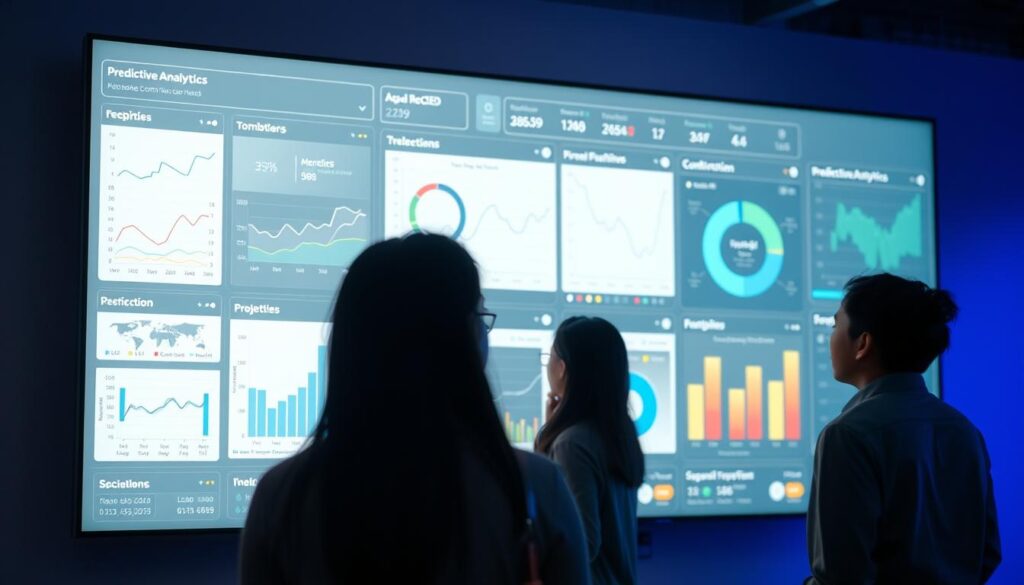Ever wondered how some businesses seem to know what you want before you ask? The answer often lies in data analytics. For companies aiming to keep customers coming back, using customer loyalty analytics is key. In Southeast Asia’s competitive markets, data helps businesses understand what customers like and don’t like.
This knowledge lets companies create strategies that meet customer needs and improve personalization. By using data to keep customers, businesses find new ways to build lasting loyalty and satisfaction.
Key Takeaways
- Data analytics is vital for enhancing customer retention & loyalty.
- Customer loyalty analytics provide key insights into customer preferences.
- Understanding customer behavior can lead to innovative retention strategies.
- Personalization, driven by data, boosts loyalty and satisfaction.
- Companies in Southeast Asia can greatly benefit from using data for retention.
Understanding the Importance of Customer Loyalty
Customer loyalty is key to a business’s success. It shows a customer’s commitment to keep buying from a brand. This loyalty comes from good experiences and satisfaction.
Businesses that focus on loyalty get a steady income. They also do well in tough markets. Knowing how loyalty works helps create lasting customer relationships.
Defining Customer Loyalty and Its Impact on Businesses
Customer loyalty means choosing a brand over others because of past experiences. This loyalty brings many benefits to businesses. One big advantage is brand advocacy.
Loyal customers often tell others about their favorite brands. This word-of-mouth marketing is very valuable. It brings in new customers with genuine recommendations.
The Financial Benefits of Retaining Customers
Keeping customers is much cheaper than getting new ones. A small 5% increase in customer retention can lead to big profits. This shows how important loyalty strategies are for a business’s health and growth.

Data Analytics Explained
Data analytics is key for businesses to understand customer behavior. It involves looking at data to find insights that help make decisions. Knowing what data analytics is can help companies use tools and methods well. There are many types of data analytics, each important for business success.
What is Data Analytics?
The data analytics definition is about looking at data to find important insights. It helps spot trends and guide decisions. By using different methods, companies can turn raw data into useful information. This makes operations better, improves customer happiness, and builds loyalty.
Using data analytics is crucial for businesses to succeed today.
Types of Data Analytics and Their Applications
Knowing the types of data analytics helps businesses better connect with customers. The main types are:
| Type | Description | Applications of Data Analytics |
|---|---|---|
| Descriptive Analytics | Looks at past data to summarize what happened. | Sales reports, customer feedback analysis. |
| Predictive Analytics | Uses past data to guess what will happen next. | Forecasting customer behavior, checking marketing campaigns. |
| Prescriptive Analytics | Gives advice on what to do based on predictions. | Improving pricing, managing supply chains. |
| Diagnostic Analytics | Studies data to understand why things happen. | Figuring out why customers leave, finding where things go wrong. |

Each type has its own role, showing how applications of data analytics vary in business. By using these analytics, companies can improve operations, keep customers, and make smart decisions that meet their goals.
Customer Retention & Loyalty Using Data Analytics
Knowing what customers like is key for businesses wanting to keep them. With the right analytics, companies can see what customers buy, like, and do. This helps them make plans that speak to each customer, building strong bonds.
Understanding Customer Behavior through Analytics
Data analytics helps businesses see how customers interact. By looking at past actions and likes, companies can guess what customers will do next. This includes checking out who they are, how often they buy, and how they like to be contacted. This helps companies like Lazada keep customers happy by meeting their needs fast.
Segmentation Strategies for Enhanced Loyalty
Using specific strategies for different customer groups makes loyalty efforts stronger. By dividing customers into groups based on what they do, who they are, or how they engage, businesses can send messages that really speak to them. For instance, some groups might love deals, while others prefer personal touches. By using these insights, companies can boost customer interaction and loyalty.
| Customer Segment | Preferred Promotion Type | Engagement Level |
|---|---|---|
| Frequent Shoppers | Exclusive Discounts | High |
| New Customers | Welcome Offers | Medium |
| Inactive Customers | Re-Engagement Campaigns | Low |
By using analytics for loyalty, businesses can make their interactions with customers better. This can lead to happier customers and stronger loyalty. For more on this, check out ethical considerations when using AI for.
The Role of Predictive Analytics in Anticipating Customer Needs
Predictive analytics is key in understanding what customers want. It uses past data and machine learning to spot trends. This helps businesses get ready for changes in the market.
Using Predictive Models to Understand Trends
Companies use predictive models to turn complex data into useful information. For example, retail stores can guess how much stock they’ll need by looking at shopping trends. This helps them keep the right amount of inventory, meeting customer needs without wasting resources.
Predictive analytics gives businesses an edge in a fast-changing market. It helps them stay ahead of the competition.
Benefits of Anticipating Customer Needs
Knowing what customers need helps businesses in many ways. It builds a stronger bond between companies and their customers. People like brands that get them.
This approach keeps customers coming back. It builds a loyal customer base. Brands like ADA show how predictive analytics can shape marketing strategies.
By understanding customer demand, companies can offer experiences that really speak to their audience. This leads to lasting loyalty and happiness.

Improving Personalization to Boost Loyalty
Personalization is key to keeping customers loyal. By making experiences fit each customer’s taste, brands can make a big difference. This not only keeps current customers but also brings in new ones through happy word-of-mouth.
How Personalization Enhances Customer Experience
Good personalization lets businesses really connect with their audience. When customers get offers that match their interests, they feel seen and valued. A study showed that using personalization can make customers happier and more likely to stay.
For example, Spotify makes playlists that fit what you like to listen to. This makes people more engaged and loyal.
Case Studies: Successful Personalization Strategies
Many brands have made customer satisfaction better with personalization. A Malaysian oil and gas company used targeted ads during the pandemic. This made customers more engaged and loyal.
| Brand | Strategy | Impact |
|---|---|---|
| Netflix | Personalized viewing recommendations | Higher user engagement and retention |
| Spotify | Curated playlists based on listening habits | Increased user satisfaction and loyalty |
| Malaysian Oil and Gas Company | Targeted marketing based on customer profiling | Heightened customer engagement |

Analyzing Customer Feedback and Sentiment
Understanding what customers think is key to better business strategies. By analyzing feedback, companies get a clear picture of what customers like and dislike. Advanced methods like sentiment analysis help figure out emotions from reviews and social media. This gives insights that help make better decisions and improve services.
Using Customer Reviews for Insights
Customer reviews are gold for businesses wanting to know their audience. By studying these reviews, companies spot trends in satisfaction and see where they can get better. For example, sentiment analysis helps brands see how customers feel about their products or services.
By sorting feedback into positive, negative, or neutral, companies can focus on what’s working and what’s not. This helps them build on their strengths and fix their weaknesses.
Real-Time Feedback Collection Techniques
Real-time feedback systems have changed how companies talk to customers. Tools like digital surveys or social media monitoring let businesses get instant feedback. This quick info helps them change their services fast to meet customer needs.
A great example is a rail transit provider in the Philippines. During the pandemic, they used customer feedback to find out what was bothering riders. By fixing these issues, they made their service better and kept more riders coming back.
Enhancing Customer Experience Through Data Insights
In today’s market, focusing on customer experience can make a business stand out. Data analytics help companies understand the customer journey. This leads to better engagement and satisfaction.
Identifying pain points in the journey helps businesses make key adjustments. These changes can greatly improve how customers feel and stay loyal.
Identifying Pain Points in the Customer Journey
Knowing how customers behave is key to finding pain points. For example, a telecom company might track customer interactions. They find out where issues like long wait times or unclear options happen.
By fixing these problems, businesses can make the customer journey smoother. This leads to better experiences for everyone.
Optimizing Touchpoints for Maximum Engagement
Once pain points are found, businesses can work on improving touchpoints. Each interaction is a chance to connect with customers. If an online store sees high cart abandonment rates, they can make checkout easier.
Improving these moments boosts satisfaction and strengthens brand loyalty. It shows customers that their experience matters.
By always checking and improving these interactions, brands create a better environment for customers. Using data to guide these efforts leads to happier customers and stronger loyalty.
Utilizing Customer Loyalty Programs Effectively
Customer loyalty programs are key to keeping clients and increasing repeat business. By using data to guide loyalty strategies, companies can make programs that fit what customers like. This approach ensures rewards match what customers value most.
Designing Data-Driven Loyalty Programs
A good loyalty program starts with deep analysis of customer data. Businesses use data on buying habits, demographics, and feedback to craft special rewards. Targeted campaigns boost engagement and participation, building strong bonds between businesses and customers.
Key Metrics to Measure Loyalty Program Success
Success in loyalty programs is measured by several key metrics. Retention rates show how well a program keeps customers coming back. The Net Promoter Score (NPS) measures satisfaction and loyalty. Customer lifetime value (CLV) shows the long-term impact of loyalty efforts.
By regularly checking these metrics, businesses can improve their loyalty programs. This ensures they meet customer needs and expectations.
Conclusion
Using customer loyalty analytics is key to success in today’s market, like in the Philippines. It helps businesses make their customer experience better, more personal, and lasting. This approach can lead to happier customers and more profit.
Companies need to keep updating their ways to keep customers coming back. They must always try to understand what their customers want. As loyalty strategies evolve, using new analytics will be essential. This way, businesses can keep their customers happy and grow.
The path to winning customer loyalty is all about using data analytics well. With these tools, brands can keep in touch with their customers. This ensures they meet their needs and keep their loyalty in a fast-changing world.

